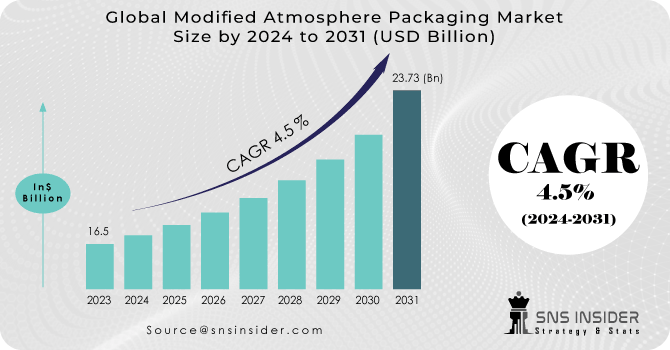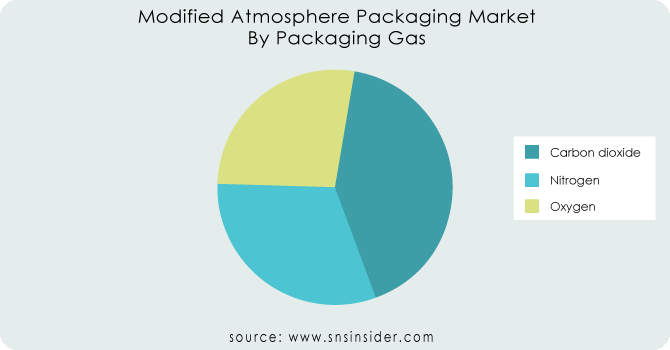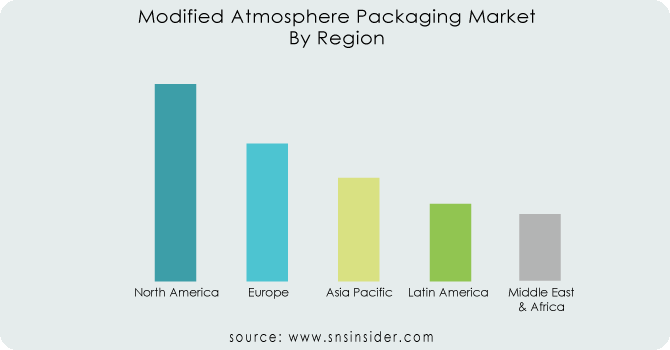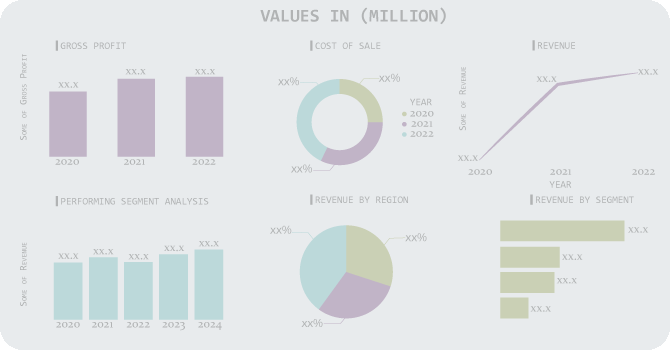Modified Atmosphere Packaging Market Report Scope & Overview
The Modified Atmosphere Packaging Market size was USD 16.5 billion in 2023 and is expected to Reach USD 23.73 billion by 2031 and grow at a CAGR of 4.5% over the forecast period of 2024-2031.
Modified atmosphere packaging plays a crucial role in preserving product freshness until it reaches consumers. It helps maintain nutritional value, visual appeal, texture, and extends shelf life. These significant benefits are driving global market growth, as this packaging type ensures the safety of perishable products and is favored by customers for its convenience. Additionally, it enables the creation of value-added products. The increasing demand for fresh, quality packaged food is a primary driver of market expansion. Furthermore, mergers, acquisitions, and new product launches by manufacturers are expected to have a positive impact on market growth. The global modified atmosphere packaging market is driven by the growing preference for convenient packaging, particularly in developed countries where there is a high demand for fresh fruits and vegetables. This technology not only reduces production costs and storage needs but also meets consumer demand for hygienic and longer shelf-life food packaging. Additionally, the market is influenced by an on-the-go lifestyle and a rising preference for fresh, high-quality packaged food, with dairy, meat, seafood, and poultry products contributing to its growth.

Get More Information on Modified atmosphere packaging Market - Request Sample Report
Modified atmosphere packaging plays a vital role in enhancing product quality and minimizing waste. For instance, by employing modified atmosphere packaging for bananas, waste has been reduced from 10% to 2% during winter and from 30% to 4% in summer.
MARKET DYNAMICS
KEY DRIVERS:
-
Increased Demand for Fresh and Quality Packaged Food
The rise in consumer awareness regarding the health benefits of fresh food consumption has spurred an increased demand for quality packaged food products. Consumers are increasingly prioritizing freshness and nutritional value in their food choices, leading to a growing market for packaged goods that emphasize these qualities.
-
The rise in merger and acquisition activities, alongside manufacturers' increased focus on extending shelf life, continues to influence the market.
RESTRAIN:
-
The market growth is anticipated to face obstacles due to the expensive development costs and strict environmental regulations.
OPPORTUNITY:
-
Increasing demand for eco-friendly packaging solutions presents opportunities for the development of biodegradable and recyclable MAP materials.
With increasing environmental awareness among consumers, there is a rising inclination towards packaging materials that are biodegradable and recyclable. This trend aligns with broader sustainability goals, and manufacturers are responding by exploring and developing innovative MAP materials that minimize environmental impact.
-
Rapid urbanization and the growing middle-class population in emerging economies offer significant growth opportunities.
CHALLENGES:
-
Ensuring the right gas mixture for different products can be challenging and requires precise control.
-
Heightened competition within the Modified Atmosphere Packaging industry poses a significant challenge to the growth of the market.
Impact of Russia Ukraine War
The Russia-Ukraine war could have varied impacts on the Modified Atmosphere Packaging (MAP) market, with potential disruptions in the supply chain being a significant concern. Ukraine's role as a key producer of agricultural products crucial for MAP materials may lead to price fluctuations and production delays. Additionally, if the conflict disrupts energy supplies or raises energy costs, it could directly impact the operational expenses of MAP packaging manufacturers, potentially resulting in higher production costs. Currency exchange rate fluctuations and economic instability stemming from the conflict may affect consumer purchasing power and overall market demand for MAP products. Export restrictions and geopolitical factors could introduce uncertainty, prompting companies to reassess supply chains and adapt to evolving market conditions. The overarching geopolitical situation may create challenges for businesses, impacting investment decisions and international partnerships within the MAP packaging industry.
Impact of Economic Slowdown
The Modified Atmosphere Packaging (MAP) market has been significantly impacted by the ongoing economic slowdown, exhibiting a diverse range of effects. While certain segments have experienced a downturn due to reduced consumer spending and industrial activities, others have shown resilience or growth, particularly in the essential sectors of food and pharmaceutical packaging. The economic impact analysis reveals reduced industrial output in various sectors, negatively affecting the demand for MAP in non-essential goods. However, a shift in consumer spending towards essential goods has somewhat sustained demand for MAP in the food and healthcare sectors. Global supply chain disruptions have further impacted MAP, affecting raw material availability and costs, resulting in increased production expenses and delays.
The provided graph visually depicts the impact of the ongoing economic slowdown on the Modified Atmosphere Packaging (MAP) market across three key parameters:
-
Market Demand: A significant 20% decline is evident, reflecting reduced demand for MAP in non-essential sectors due to decreased consumer spending and industrial output.
-
Production Costs: Production costs have surged by 30%, indicated by the upward bar. This increase is attributed to disruptions in the supply chain affecting raw material availability and pricing, coupled with heightened operational costs amid the economic slowdown.
-
Innovation & Sustainability: Despite economic challenges, there's a positive 10% change in innovation and sustainability efforts. Companies are strategically focusing on developing more cost-effective, efficient, and sustainable MAP solutions to stay competitive and align with shifting consumer preferences.
KEY MARKET SEGMENTS
By Packaging Material
-
Polyethylene
-
Polyvinylchloride
-
Ethylene Vinyl Alcohol
-
Polypropylene
-
Others
The growth of the global modified atmospheric packaging market is primarily driven by ethylene vinyl alcohol. This material offers superior gas barrier properties and is easily processed. It effectively prevents oxygen ingress while maintaining the levels of nitrogen and carbon dioxide required for modified atmosphere packaging. Moreover, ethylene vinyl alcohol demonstrates high resistance to oils and preserves the taste and aroma of packaged products, contributing to the growth of this segment.
By Packaging Gas
-
Nitrogen
-
Oxygen
-
Carbon dioxide
Carbon dioxide is the predominant segment, particularly crucial in food packaging under modified atmospheres. Increased concentrations of carbon dioxide extend the shelf life of perishable foods, as it inhibits oxidation and the growth of aerobic bacteria and molds. Widely used for enhancing food shelf life, carbon dioxide is anticipated to experience rapid growth in the coming years.

Get Customized Report as per Your Business Requirement - Request For Customized Report
By Technology
-
Tray-Sealer Machine
-
Horizontal and Vertical Flow Packaging Machine
-
Deep-Drawing Machine
-
Vacuum Chamber Machine
-
Bag-Sealing Machine
-
Others
Tray-sealer machines are utilized to seal products in trays or containers, ensuring optimal product protection and presentation. They find extensive application across fresh and processed food packaging, pharmaceuticals, and consumer goods. Horizontal machines specialize in wrapping products such as bars, bakery items, and hardware, while vertical machines excel in packaging candies, grains, and liquids. Their market has grown due to their speed, flexibility, and capability to create airtight packages. These machines enhance product visibility and maintain consistent, high-quality packaging.
By End User
-
Fruits & Vegetables
-
Bakery & Confectionary
-
Dairy Products
-
Seafood & Meat Products
-
Others
The bakery and confectionery segment holds the leading position among the various application sectors in the global modified atmospheric packaging market. This category encompasses a wide array of bread-based items. To prolong shelf life and enhance freshness, bread-based products necessitate packaging solutions with a significant amount of carbon dioxide, thus amplifying the effectiveness of modified atmosphere packaging. Additionally, the robust global consumer demand for bakery and confectionery goods is a key factor propelling the growth of this segment.
REGIONAL ANALYSIS
North America is anticipated to lead the global modified atmosphere packaging market. The growth is attributed to factors such as the rising adoption of fresh and high-quality packaged food, the demand for hygienic packaging, producers' need for extended shelf life, and the prevalence of on-the-go lifestyles. Europe holds the second-largest share in the global modified atmospheric packaging market and is expected to significantly contribute to market growth in the forecast period. Germany, a leading meat producer in the EU, particularly dominates in pork production and export, as well as beef production. This drives the demand for proper meat packaging, thereby boosting the growth of the modified atmospheric packaging market. The Asia-Pacific region is witnessing robust growth in the MAP market due to factors such as rising urbanization, evolving dietary habits, and a burgeoning middle-class population. Countries like China and India are experiencing increased consumption of packaged foods, leading to heightened demand for MAP solutions. The growth of e-commerce further influences the demand for efficient packaging solutions, with a focus on food safety and extending product shelf life.
In Latin America, countries like Brazil, Mexico, and Argentina drive diverse dynamics in the MAP sector, driven by agriculture and food processing demands for fruits, vegetables, and meat. Economic factors and consumer choices influence MAP trends, emphasizing sustainability and cost efficiency. Meanwhile, in the Middle East and Africa, population growth, urbanization, and consumer awareness fuel MAP market growth, aiming to reduce food waste and improve food safety, leading to industry evolution to meet diverse sector needs like food and pharmaceuticals.

REGIONAL COVERAGE:
North America
-
US
-
Canada
-
Mexico
Europe
-
Eastern Europe
-
Poland
-
Romania
-
Hungary
-
Turkey
-
Rest of Eastern Europe
-
-
Western Europe
-
Germany
-
France
-
UK
-
Italy
-
Spain
-
Netherlands
-
Switzerland
-
Austria
-
Rest of Western Europe
-
Asia Pacific
-
China
-
India
-
Japan
-
South Korea
-
Vietnam
-
Singapore
-
Australia
-
Rest of Asia Pacific
Middle East & Africa
-
Middle East
-
UAE
-
Egypt
-
Saudi Arabia
-
Qatar
-
Rest of Middle East
-
-
Africa
-
Nigeria
-
South Africa
-
Rest of Africa
-
Latin America
-
Brazil
-
Argentina
-
Colombia
-
Rest of Latin America
Key Players
Some of the major players in the Modified Atmosphere Packaging Market are Berry Global Inc., Amcor plc, Praxair Technology, Inc., CVP Systems, Inc., Bemis Company, Inc., Ilapak International S.A., Coveris Holdings S.A, GEA Group, Hayssen Flexible Systems, Air Products and Chemicals, Inc. and other players.
Berry Global Inc-Company Financial Analysis

RECENT DEVELOPMENTS
-
In August 2022, Amcor (NYSE: AMCR) (ASX: AMC), renowned for its commitment to creating sustainable packaging solutions, finalized the acquisition of a top-tier flexible packaging facility located in the Czech Republic.
-
In July 2022, Amcor received dual recognition for its innovations in eco-friendly packaging. The company was named a 2022 Sustainability Leader in the Australian Financial Review's (AFR) annual list and also received a silver award from the Australasian Packaging Innovation and Design Awards (PIDA) in 2022.
-
Berry M&H introduced the Mira 475ml bottle for table sauces and condiments on September 22, 2021, in response to growing consumer preferences for convenient and sustainable packaging. Made from polypropylene (PP), this bottle is recyclable after use. It features an EVOH barrier layer, ensuring excellent
| Report Attributes | Details |
|---|---|
| Market Size in 2023 | US$ 16.5 Billion |
| Market Size by 2031 | US$ 23.73 Billion |
| CAGR | CAGR of 4.5 % From 2024 to 2031 |
| Base Year | 2023 |
| Forecast Period | 2024-2031 |
| Historical Data | 2020-2022 |
| Report Scope & Coverage | Market Size, Segments Analysis, Competitive Landscape, Regional Analysis, DROC & SWOT Analysis, Forecast Outlook |
| Key Segments | • By Packaging Material (Polyethylene, Polyvinylchloride, Ethylene Vinyl Alcohol, Polypropylene, Others) • By Packaging Gas (Nitrogen, Oxygen, Carbon Dioxide) • By Technology (Tray-Sealer Machine, Horizontal And Vertical Flow Packaging Machine, Deep-Drawing Machine, Vacuum Chamber Machine, Bag-Sealing Machine, Others) • By End User (Fruits & Vegetables, Bakery & Confectionary, Dairy Products, Seafood & Meat Products, Others) |
| Regional Analysis/Coverage | North America (US, Canada, Mexico), Europe (Eastern Europe [Poland, Romania, Hungary, Turkey, Rest of Eastern Europe] Western Europe] Germany, France, UK, Italy, Spain, Netherlands, Switzerland, Austria, Rest of Western Europe]), Asia Pacific (China, India, Japan, South Korea, Vietnam, Singapore, Australia, Rest of Asia Pacific), Middle East & Africa (Middle East [UAE, Egypt, Saudi Arabia, Qatar, Rest of Middle East], Africa [Nigeria, South Africa, Rest of Africa], Latin America (Brazil, Argentina, Colombia, Rest of Latin America) |
| Company Profiles | erry Global Inc., Amcor plc, Praxair Technology, Inc., CVP Systems, Inc., Bemis Company, Inc., Ilapak International S.A., Coveris Holdings S.A, GEA Group, Hayssen Flexible Systems, Air Products and Chemicals, Inc. |
| Key Drivers | • Increased Demand for Fresh and Quality Packaged Food • The rise in merger and acquisition activities, alongside manufacturers' increased focus on extending shelf life, continues to influence the market. |
| Restraints | • The market growth is anticipated to face obstacles due to the expensive development costs and strict environmental regulations. |

